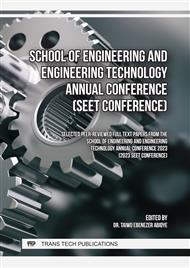[1]
U.M. Qureshi, F.K. Shaikh, Z. Aziz, S.M.Z.S. Shah, A.A. Sheikh, E. Felemban, and S.B. Qaisar, RF path and absorption loss estimation for underwater wireless sensor networks in different water environments, Sensors, 16(890): 1-15, (2016).
DOI: 10.3390/s16060890
Google Scholar
[2]
L. Matthew, Y.P. Singh, and S. Sharma, An extensive study on under-water communication using LED/LASER enabled Li-Fi modules, International Journal of Innovative Research in Science Engineering and Technology, 5(11): 19435-19440, (2016).
Google Scholar
[3]
T.S. Asha, and K. Drisya, Visible light communication (VLC) and its applications, International Advanced Research Journal in Science, Engineering and Technology, 6(2): 72 – 90, (2019).
Google Scholar
[4]
B. Soner and S.C. Ergen, Vehicular visible light positioning with a single receiver, IEEE 30th Annual International Symposium on Personal, Indoor and Mobile Radio Communications (PIMRC), pp.1-6, (2019).
DOI: 10.1109/pimrc.2019.8904408
Google Scholar
[5]
W. Zhao, M. Kamezaki, K. Yamaguchi, M. Konno, A. Onuki, and S. Sugano, Investigation on image signal receiving performance of photodiodes and solar panel detectors in an underground facility visible light communication system, Optics Express, 29(2): 692-705, (2021).
DOI: 10.1364/oe.413026
Google Scholar
[6]
J. Moritz, Audio-to-optical conversion and transmission, Electrical Engineering Department, California Polytechnic State University, USA, (2011).
Google Scholar
[7]
L.C. Png, A fully integrated audio, video, and data VLC transceiver system for smartphones and tablets, IEEE 17th International Symposium on Consumer Electronics (ISCE), 249-250, (2013).
DOI: 10.1109/isce.2013.6570210
Google Scholar
[8]
Y. He, L. Ding, Y. Gong, and Y. Wang, Real-time audio and video transmission system based on visible light communication, Optics and Photonics Journal, 3(2): 153-157, (2013).
DOI: 10.4236/opj.2013.32b037
Google Scholar
[9]
L.C. Png, S.X. Lim, A. Rajamohan, B. Chen, and F.A. Hazman, Design of VLC transceiver circuits for reading light transmission of high-quality audio signals on commercial airliners interaction, IEEE International Symposium on Consumer Electronics, Taiwan, 97 – 98, (2014).
DOI: 10.1109/icce-tw.2014.6904119
Google Scholar
[10]
First Sensor Pin PD Data Sheet, 1-3, (2013).
Google Scholar
[11]
V. Ramalingam, Thermal efficiency improvement of solar PV module by spectral absorption using water, National Conference on Green Energy-NGE 2013: 1-6, (2013).
Google Scholar
[12]
Z. Wang, D. Tsonev, S. Videv, and H. Haas, On the design of a solar-panel receiver for optical wireless communications with simultaneous energy harvesting, IEEE Journal on Selected Areas in Communication., 33(8): 1612 – 1623, (2015).
DOI: 10.1109/jsac.2015.2391811
Google Scholar
[13]
R. Sarwar, B. Sun, M. Kong, T. Ali, C. Yu, B. Cong, and J. Xu, Visible light communication using a solar panel receiver, 16th International Conference on Optical Communications and Networks (ICOCN): 1-3, (2017).
DOI: 10.1109/icocn.2017.8121577
Google Scholar
[14]
X. Chen, C. Min, and J. Guo, Visible light communication system using silicon photocell for energy gathering and data receiving, International Journal of Optics, Vol. 2017, Article ID 6207123, 1-5, (2017).
DOI: 10.1155/2017/6207123
Google Scholar
[15]
S.A. Kumar, L. Akash, and J. Deenadyalan, Visible light communication, International Journal of Science and Research, 7(5): 715-720, (2018).
Google Scholar
[16]
M. Kong, B. Sun, R. Sarwar, J. Shen, Y. Chen, F. Qu, J. Han, J. Chen, H. Qin, and J. Xu, Underwater wireless optical communication using a lens-free solar panel receiver, Optics Communications, 426: 94 -98, (2018).
DOI: 10.1016/j.optcom.2018.05.019
Google Scholar
[17]
A.M. Humada, S.Y. Darweesh, K.G. Mohammed, M. Kamile, S.F. Mohammed, N.K. Kasim, T.A. Tahseen, O.I. Awad, and S. Mekhile, Modeling of PV system and parameter extraction based on experimental data: Review and investigation, Solar Energy, 199: 742-760, (2020).
DOI: 10.1016/j.solener.2020.02.068
Google Scholar
[18]
A.M. Zaiton, H.R. Muhammad, and F. Jasman, Solar panel receiver characterisation for indoor visible light communication system, Journal of Physics: Conference Series, 1502: 1-6, (2020).
DOI: 10.1088/1742-6596/1502/1/012016
Google Scholar
[19]
Z. Tong, X. Yang, H. Zhang, Y. Dai, X. Chen, J. Xu, "Series-connected solar array for high-speed underwater wireless optical links," Optics Letters, 47(5): 1013-1016, (2022).
DOI: 10.1364/ol.449466
Google Scholar
[20]
S. Biswas, and H. Kim, Solar cells for indoor applications, progress and development, polymers, 12(1338): 1-23, (2020).
Google Scholar
[21]
D. Ma, G. Lan, M. Hassan, W. Hu, and S.K. Das, Sensing, computing, and communications for energy harvesting IoTs: A survey. IEEE Communication Survey Tutorial, 22(4): 1222–1250, (2020).
DOI: 10.1109/comst.2019.2962526
Google Scholar
[22]
J. Fakidis, H. Helmers, and H. Haas, Simultaneous wireless data and power transfer for a 1-Gb/s GaAs VCSEL and photovoltaic link. IEEE Photonics Technology Letters, 32(19): 1277–1280, (2020).
DOI: 10.1109/lpt.2020.3018960
Google Scholar
[23]
M. Kong, C. H. Kang, O. Alkhazragi, X. Sun, Y. Guo, M. Sait, J. A. Holguin-Lerma, T. K. Ng, and B. S. Ooi, Survey of energy-autonomous solar cell receivers for satellite–air–ground–ocean optical wireless communication, Progress in Quantum Electronics, 74, (2020), 100300.
DOI: 10.1016/j.pquantelec.2020.100300
Google Scholar
[24]
T. Sanislav, G.D. Mois, S. Zeadally, and S.C. Folea, Energy harvesting techniques for internet of things (IoT). IEEE Access, 9: 39530–39549, (2021).
DOI: 10.1109/access.2021.3064066
Google Scholar
[25]
W. Lei, Z. Chen, Y. Xu, C. Jiang, J. Lin, and J. Fang, Negatively biased solar cell optical receiver for underwater wireless optical communication system with low peak average power ratio. IEEE Photonics Journal, 14(4): 1-9, (2022).
DOI: 10.1109/jphot.2022.3186702
Google Scholar
[26]
O. Alamu, T.O. Olwal, and K. Djouani, Simultaneous lightwave information and power transfer in optical wireless communication networks: An overview and outlook. Optik- International Journal for Light and Electron Optics, 266(169590): 1-27, (2022).
DOI: 10.1016/j.ijleo.2022.169590
Google Scholar
[27]
M. Rosa-Clot, and G.M. Tina, Submerged and floating photovoltaic systems (modeling, design and case studies), 1st Edition, Academic Press, 33-64, USA, (2017).
Google Scholar
[28]
J.H. Scofield, Effects of series resistance and inductance on solar cell admittance measurements, Solar Energy Materials and Solar Cells, 37(2): 217 – 233, (1995).
DOI: 10.1016/0927-0248(95)00016-x
Google Scholar


